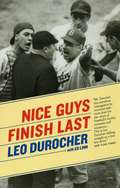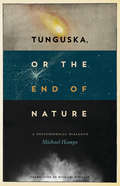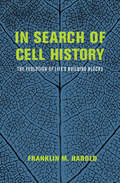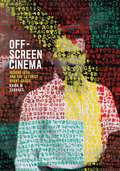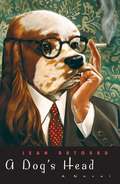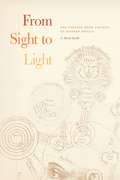- Table View
- List View
Nice Guys Finish Last
by Leo Durocher Ed Linn“I believe in rules. Sure I do. If there weren't any rules, how could you break them?” The history of baseball is rife with colorful characters. But for sheer cantankerousness, fighting moxie, and will to win, very few have come close to Leo “the Lip” Durocher. Following a five-decade career as a player and manager for baseball’s most storied franchises, Durocher teamed up with veteran sportswriter Ed Linn to tell the story of his life in the game. The resulting book, Nice Guys Finish Last, is baseball at its best, brimming with personality and full of all the fights and feuds, triumphs and tricks that made Durocher such a success—and an outsized celebrity. Durocher began his career inauspiciously, riding the bench for the powerhouse 1928 Yankees and hitting so poorly that Babe Ruth nicknamed him “the All-American Out.” But soon Durocher hit his stride: traded to St. Louis, he found his headlong play and never-say-die attitude a perfect fit with the rambunctious “Gashouse Gang” Cardinals. In 1939, he was named player-manager of the Brooklyn Dodgers—and almost instantly transformed the underachieving Bums into perennial contenders. He went on to manage the New York Giants, sharing the glory of one of the most famous moments in baseball history, Bobby Thomson’s “shot heard ’round the world,” which won the Giants the 1951 pennant. Durocher would later learn how it felt to be on the other side of such an unforgettable moment, as his 1969 Cubs, after holding first place for 105 days, blew a seemingly insurmountable 8-1/2-game lead to the Miracle Mets. All the while, Durocher made as much noise off the field as on it. His perpetual feuds with players, owners, and league officials—not to mention his public associations with gamblers, riffraff, and Hollywood stars like George Raft and Larraine Day—kept his name in the headlines and spread his fame far beyond the confines of the diamond. A no-holds-barred account of a singular figure, Nice Guys Finish Last brings the personalities and play-by-play of baseball’s greatest era to vivid life, earning a place on every baseball fan’s bookshelf.
In Search of a Lost Avant-Garde: An Anthropologist Investigates the Contemporary Art Museum
by Matti BunzlIn 2008, anthropologist Matti Bunzl was given rare access to observe the curatorial department of Chicago’s Museum of Contemporary Art. For five months, he sat with the institution’s staff, witnessing firsthand what truly goes on behind the scenes at a contemporary art museum. From fund-raising and owner loans to museum-artist relations to the immense effort involved in safely shipping sixty works from twenty-seven lenders in fourteen cities and five countries, Matti Bunzl’s In Search of a Lost Avant-Garde illustrates the inner workings of one of Chicago’s premier cultural institutions. Bunzl’s ethnography is designed to show how a commitment to the avant-garde can come into conflict with an imperative for growth, leading to the abandonment of the new and difficult in favor of the entertaining and profitable. Jeff Koons, whose massive retrospective debuted during Bunzl's research, occupies a central place in his book and exposes the anxieties caused by such seemingly pornographic work as the infamous Made in Heaven series. Featuring cameos by other leading artists, including Liam Gillick, Jenny Holzer, Karen Kilimnik, and Tino Sehgal, the drama Bunzl narrates is palpable and entertaining and sheds an altogether new light on the contemporary art boom.
In Search of a Lost Avant-Garde: An Anthropologist Investigates the Contemporary Art Museum
by Matti BunzlIn 2008, anthropologist Matti Bunzl was given rare access to observe the curatorial department of Chicago’s Museum of Contemporary Art. For five months, he sat with the institution’s staff, witnessing firsthand what truly goes on behind the scenes at a contemporary art museum. From fund-raising and owner loans to museum-artist relations to the immense effort involved in safely shipping sixty works from twenty-seven lenders in fourteen cities and five countries, Matti Bunzl’s In Search of a Lost Avant-Garde illustrates the inner workings of one of Chicago’s premier cultural institutions. Bunzl’s ethnography is designed to show how a commitment to the avant-garde can come into conflict with an imperative for growth, leading to the abandonment of the new and difficult in favor of the entertaining and profitable. Jeff Koons, whose massive retrospective debuted during Bunzl's research, occupies a central place in his book and exposes the anxieties caused by such seemingly pornographic work as the infamous Made in Heaven series. Featuring cameos by other leading artists, including Liam Gillick, Jenny Holzer, Karen Kilimnik, and Tino Sehgal, the drama Bunzl narrates is palpable and entertaining and sheds an altogether new light on the contemporary art boom.
In Search of a Lost Avant-Garde: An Anthropologist Investigates the Contemporary Art Museum
by Matti BunzlIn 2008, anthropologist Matti Bunzl was given rare access to observe the curatorial department of Chicago’s Museum of Contemporary Art. For five months, he sat with the institution’s staff, witnessing firsthand what truly goes on behind the scenes at a contemporary art museum. From fund-raising and owner loans to museum-artist relations to the immense effort involved in safely shipping sixty works from twenty-seven lenders in fourteen cities and five countries, Matti Bunzl’s In Search of a Lost Avant-Garde illustrates the inner workings of one of Chicago’s premier cultural institutions. Bunzl’s ethnography is designed to show how a commitment to the avant-garde can come into conflict with an imperative for growth, leading to the abandonment of the new and difficult in favor of the entertaining and profitable. Jeff Koons, whose massive retrospective debuted during Bunzl's research, occupies a central place in his book and exposes the anxieties caused by such seemingly pornographic work as the infamous Made in Heaven series. Featuring cameos by other leading artists, including Liam Gillick, Jenny Holzer, Karen Kilimnik, and Tino Sehgal, the drama Bunzl narrates is palpable and entertaining and sheds an altogether new light on the contemporary art boom.
In Search of a Lost Avant-Garde: An Anthropologist Investigates the Contemporary Art Museum
by Matti BunzlIn 2008, anthropologist Matti Bunzl was given rare access to observe the curatorial department of Chicago’s Museum of Contemporary Art. For five months, he sat with the institution’s staff, witnessing firsthand what truly goes on behind the scenes at a contemporary art museum. From fund-raising and owner loans to museum-artist relations to the immense effort involved in safely shipping sixty works from twenty-seven lenders in fourteen cities and five countries, Matti Bunzl’s In Search of a Lost Avant-Garde illustrates the inner workings of one of Chicago’s premier cultural institutions. Bunzl’s ethnography is designed to show how a commitment to the avant-garde can come into conflict with an imperative for growth, leading to the abandonment of the new and difficult in favor of the entertaining and profitable. Jeff Koons, whose massive retrospective debuted during Bunzl's research, occupies a central place in his book and exposes the anxieties caused by such seemingly pornographic work as the infamous Made in Heaven series. Featuring cameos by other leading artists, including Liam Gillick, Jenny Holzer, Karen Kilimnik, and Tino Sehgal, the drama Bunzl narrates is palpable and entertaining and sheds an altogether new light on the contemporary art boom.
In Search of a Lost Avant-Garde: An Anthropologist Investigates the Contemporary Art Museum
by Matti BunzlIn 2008, anthropologist Matti Bunzl was given rare access to observe the curatorial department of Chicago’s Museum of Contemporary Art. For five months, he sat with the institution’s staff, witnessing firsthand what truly goes on behind the scenes at a contemporary art museum. From fund-raising and owner loans to museum-artist relations to the immense effort involved in safely shipping sixty works from twenty-seven lenders in fourteen cities and five countries, Matti Bunzl’s In Search of a Lost Avant-Garde illustrates the inner workings of one of Chicago’s premier cultural institutions. Bunzl’s ethnography is designed to show how a commitment to the avant-garde can come into conflict with an imperative for growth, leading to the abandonment of the new and difficult in favor of the entertaining and profitable. Jeff Koons, whose massive retrospective debuted during Bunzl's research, occupies a central place in his book and exposes the anxieties caused by such seemingly pornographic work as the infamous Made in Heaven series. Featuring cameos by other leading artists, including Liam Gillick, Jenny Holzer, Karen Kilimnik, and Tino Sehgal, the drama Bunzl narrates is palpable and entertaining and sheds an altogether new light on the contemporary art boom.
In Search of a Lost Avant-Garde: An Anthropologist Investigates the Contemporary Art Museum
by Matti BunzlIn 2008, anthropologist Matti Bunzl was given rare access to observe the curatorial department of Chicago’s Museum of Contemporary Art. For five months, he sat with the institution’s staff, witnessing firsthand what truly goes on behind the scenes at a contemporary art museum. From fund-raising and owner loans to museum-artist relations to the immense effort involved in safely shipping sixty works from twenty-seven lenders in fourteen cities and five countries, Matti Bunzl’s In Search of a Lost Avant-Garde illustrates the inner workings of one of Chicago’s premier cultural institutions. Bunzl’s ethnography is designed to show how a commitment to the avant-garde can come into conflict with an imperative for growth, leading to the abandonment of the new and difficult in favor of the entertaining and profitable. Jeff Koons, whose massive retrospective debuted during Bunzl's research, occupies a central place in his book and exposes the anxieties caused by such seemingly pornographic work as the infamous Made in Heaven series. Featuring cameos by other leading artists, including Liam Gillick, Jenny Holzer, Karen Kilimnik, and Tino Sehgal, the drama Bunzl narrates is palpable and entertaining and sheds an altogether new light on the contemporary art boom.
Tunguska, or the End of Nature: A Philosophical Dialogue
by Michael HampeOn June 30, 1908, a mysterious explosion erupted in the skies over a vast woodland area of Siberia. Known as the Tunguska Event, it has been a source of wild conjecture over the past century, attributed to causes ranging from meteors to a small black hole to antimatter. In this imaginative book, Michael Hampe sets four fictional men based on real-life scholars—a physicist (Günter Hasinger and Steven Weinberg), a philosopher (Paul Feyerabend), a biologist (Adolf Portmann), and a mathematician (Alfred North Whitehead)—adrift on the open ocean, in a dense fog, to discuss what they think happened. The result is a playful and highly illuminating exploration of the definition of nature, mankind’s role within it, and what its end might be. Tunguska, Or the End of Nature uses its four-man setup to tackle some of today’s burning issues—such as climate change, environmental destruction, and resource management—from a diverse range of perspectives. With a kind of foreboding, it asks what the world was like, and will be like, without us, whether we are negligible and the universe random, whether nature can truly be explained, whether it is good or evil, or whether nature is simply a thought we think. This is a profoundly unique work, a thrillingly interdisciplinary piece of scholarly literature that probes the mysteries of nature and humans alike.
Tunguska, or the End of Nature: A Philosophical Dialogue
by Michael HampeOn June 30, 1908, a mysterious explosion erupted in the skies over a vast woodland area of Siberia. Known as the Tunguska Event, it has been a source of wild conjecture over the past century, attributed to causes ranging from meteors to a small black hole to antimatter. In this imaginative book, Michael Hampe sets four fictional men based on real-life scholars—a physicist (Günter Hasinger and Steven Weinberg), a philosopher (Paul Feyerabend), a biologist (Adolf Portmann), and a mathematician (Alfred North Whitehead)—adrift on the open ocean, in a dense fog, to discuss what they think happened. The result is a playful and highly illuminating exploration of the definition of nature, mankind’s role within it, and what its end might be. Tunguska, Or the End of Nature uses its four-man setup to tackle some of today’s burning issues—such as climate change, environmental destruction, and resource management—from a diverse range of perspectives. With a kind of foreboding, it asks what the world was like, and will be like, without us, whether we are negligible and the universe random, whether nature can truly be explained, whether it is good or evil, or whether nature is simply a thought we think. This is a profoundly unique work, a thrillingly interdisciplinary piece of scholarly literature that probes the mysteries of nature and humans alike.
Tunguska, or the End of Nature: A Philosophical Dialogue
by Michael HampeOn June 30, 1908, a mysterious explosion erupted in the skies over a vast woodland area of Siberia. Known as the Tunguska Event, it has been a source of wild conjecture over the past century, attributed to causes ranging from meteors to a small black hole to antimatter. In this imaginative book, Michael Hampe sets four fictional men based on real-life scholars—a physicist (Günter Hasinger and Steven Weinberg), a philosopher (Paul Feyerabend), a biologist (Adolf Portmann), and a mathematician (Alfred North Whitehead)—adrift on the open ocean, in a dense fog, to discuss what they think happened. The result is a playful and highly illuminating exploration of the definition of nature, mankind’s role within it, and what its end might be. Tunguska, Or the End of Nature uses its four-man setup to tackle some of today’s burning issues—such as climate change, environmental destruction, and resource management—from a diverse range of perspectives. With a kind of foreboding, it asks what the world was like, and will be like, without us, whether we are negligible and the universe random, whether nature can truly be explained, whether it is good or evil, or whether nature is simply a thought we think. This is a profoundly unique work, a thrillingly interdisciplinary piece of scholarly literature that probes the mysteries of nature and humans alike.
Tunguska, or the End of Nature: A Philosophical Dialogue
by Michael HampeOn June 30, 1908, a mysterious explosion erupted in the skies over a vast woodland area of Siberia. Known as the Tunguska Event, it has been a source of wild conjecture over the past century, attributed to causes ranging from meteors to a small black hole to antimatter. In this imaginative book, Michael Hampe sets four fictional men based on real-life scholars—a physicist (Günter Hasinger and Steven Weinberg), a philosopher (Paul Feyerabend), a biologist (Adolf Portmann), and a mathematician (Alfred North Whitehead)—adrift on the open ocean, in a dense fog, to discuss what they think happened. The result is a playful and highly illuminating exploration of the definition of nature, mankind’s role within it, and what its end might be. Tunguska, Or the End of Nature uses its four-man setup to tackle some of today’s burning issues—such as climate change, environmental destruction, and resource management—from a diverse range of perspectives. With a kind of foreboding, it asks what the world was like, and will be like, without us, whether we are negligible and the universe random, whether nature can truly be explained, whether it is good or evil, or whether nature is simply a thought we think. This is a profoundly unique work, a thrillingly interdisciplinary piece of scholarly literature that probes the mysteries of nature and humans alike.
In Search of Cell History: The Evolution of Life's Building Blocks
by Franklin M. HaroldThe origin of cells remains one of the most fundamental problems in biology, one that over the past two decades has spawned a large body of research and debate. With In Search of Cell History, Franklin M. Harold offers a comprehensive, impartial take on that research and the controversies that keep the field in turmoil. Written in accessible language and complemented by a glossary for easy reference, this book investigates the full scope of cellular history. Assuming only a basic knowledge of cell biology, Harold examines such pivotal subjects as the relationship between cells and genes; the central role of bioenergetics in the origin of life; the status of the universal tree of life with its three stems and viral outliers; and the controversies surrounding the last universal common ancestor. He also delves deeply into the evolution of cellular organization, the origin of complex cells, and the incorporation of symbiotic organelles, and considers the fossil evidence for the earliest life on earth. In Search of Cell History shows us just how far we have come in understanding cell evolution—and the evolution of life in general—and how far we still have to go.
In Search of Cell History: The Evolution of Life's Building Blocks
by Franklin M. HaroldThe origin of cells remains one of the most fundamental problems in biology, one that over the past two decades has spawned a large body of research and debate. With In Search of Cell History, Franklin M. Harold offers a comprehensive, impartial take on that research and the controversies that keep the field in turmoil. Written in accessible language and complemented by a glossary for easy reference, this book investigates the full scope of cellular history. Assuming only a basic knowledge of cell biology, Harold examines such pivotal subjects as the relationship between cells and genes; the central role of bioenergetics in the origin of life; the status of the universal tree of life with its three stems and viral outliers; and the controversies surrounding the last universal common ancestor. He also delves deeply into the evolution of cellular organization, the origin of complex cells, and the incorporation of symbiotic organelles, and considers the fossil evidence for the earliest life on earth. In Search of Cell History shows us just how far we have come in understanding cell evolution—and the evolution of life in general—and how far we still have to go.
In Search of Cell History: The Evolution of Life's Building Blocks
by Franklin M. HaroldThe origin of cells remains one of the most fundamental problems in biology, one that over the past two decades has spawned a large body of research and debate. With In Search of Cell History, Franklin M. Harold offers a comprehensive, impartial take on that research and the controversies that keep the field in turmoil. Written in accessible language and complemented by a glossary for easy reference, this book investigates the full scope of cellular history. Assuming only a basic knowledge of cell biology, Harold examines such pivotal subjects as the relationship between cells and genes; the central role of bioenergetics in the origin of life; the status of the universal tree of life with its three stems and viral outliers; and the controversies surrounding the last universal common ancestor. He also delves deeply into the evolution of cellular organization, the origin of complex cells, and the incorporation of symbiotic organelles, and considers the fossil evidence for the earliest life on earth. In Search of Cell History shows us just how far we have come in understanding cell evolution—and the evolution of life in general—and how far we still have to go.
In Search of Cell History: The Evolution of Life's Building Blocks
by Franklin M. HaroldThe origin of cells remains one of the most fundamental problems in biology, one that over the past two decades has spawned a large body of research and debate. With In Search of Cell History, Franklin M. Harold offers a comprehensive, impartial take on that research and the controversies that keep the field in turmoil. Written in accessible language and complemented by a glossary for easy reference, this book investigates the full scope of cellular history. Assuming only a basic knowledge of cell biology, Harold examines such pivotal subjects as the relationship between cells and genes; the central role of bioenergetics in the origin of life; the status of the universal tree of life with its three stems and viral outliers; and the controversies surrounding the last universal common ancestor. He also delves deeply into the evolution of cellular organization, the origin of complex cells, and the incorporation of symbiotic organelles, and considers the fossil evidence for the earliest life on earth. In Search of Cell History shows us just how far we have come in understanding cell evolution—and the evolution of life in general—and how far we still have to go.
In Search of Cell History: The Evolution of Life's Building Blocks
by Franklin M. HaroldThe origin of cells remains one of the most fundamental problems in biology, one that over the past two decades has spawned a large body of research and debate. With In Search of Cell History, Franklin M. Harold offers a comprehensive, impartial take on that research and the controversies that keep the field in turmoil. Written in accessible language and complemented by a glossary for easy reference, this book investigates the full scope of cellular history. Assuming only a basic knowledge of cell biology, Harold examines such pivotal subjects as the relationship between cells and genes; the central role of bioenergetics in the origin of life; the status of the universal tree of life with its three stems and viral outliers; and the controversies surrounding the last universal common ancestor. He also delves deeply into the evolution of cellular organization, the origin of complex cells, and the incorporation of symbiotic organelles, and considers the fossil evidence for the earliest life on earth. In Search of Cell History shows us just how far we have come in understanding cell evolution—and the evolution of life in general—and how far we still have to go.
In Search of Cell History: The Evolution of Life's Building Blocks
by Franklin M. HaroldThe origin of cells remains one of the most fundamental problems in biology, one that over the past two decades has spawned a large body of research and debate. With In Search of Cell History, Franklin M. Harold offers a comprehensive, impartial take on that research and the controversies that keep the field in turmoil. Written in accessible language and complemented by a glossary for easy reference, this book investigates the full scope of cellular history. Assuming only a basic knowledge of cell biology, Harold examines such pivotal subjects as the relationship between cells and genes; the central role of bioenergetics in the origin of life; the status of the universal tree of life with its three stems and viral outliers; and the controversies surrounding the last universal common ancestor. He also delves deeply into the evolution of cellular organization, the origin of complex cells, and the incorporation of symbiotic organelles, and considers the fossil evidence for the earliest life on earth. In Search of Cell History shows us just how far we have come in understanding cell evolution—and the evolution of life in general—and how far we still have to go.
Off-Screen Cinema: Isidore Isou and the Lettrist Avant-Garde
by Kaira M. CabañasOne of the most important avant-garde movements of postwar Paris was Lettrism, which crucially built an interest in the relationship between writing and image into projects in poetry, painting, and especially cinema. Highly influential, the Lettrists served as a bridge of sorts between the earlier works of the Dadaists and Surrealists and the later Conceptual artists. Off-Screen Cinema is the first monograph in English of the Lettrists. Offering a full portrait of the avant-garde scene of 1950s Paris, it focuses on the film works of key Lettrist figures like Gil J Wolman, Maurice Lemaître, François Dufrêne, and especially the movement's founder, Isidore Isou, a Romanian immigrant whose “discrepant editing” deliberately uncoupled image and sound. Through Cabañas's history, we see not only the full scope of the Lettrist project, but also its clear influence on Situationism, the French New Wave, the New Realists, as well as American filmmakers such as Stan Brakhage.
A Dog's Head (Phoenix Fiction)
by Jean DutourdJean Dutourd's A Dog's Head is a wonderful piece of magical realism, reminiscent of Voltaire, Borges and Kafka. With biting wit, Dutourd presents the story of Edmund Du Chaillu, a boy born, to his bourgeois parents's horror, with the head of a spaniel. Edmund must endure his school-mate's teasing as well as an urge to carry a newspaper in his mouth. This is the story of his life, trials, and joys as he searches for a normal life of worth and love. "Dutourd is a fine craftsman, whose work has the classic virtues of brevity, lucidity, and concentration. He has written a sardonic divertissement that concerns itself with fundamental problems of man's existence-a tale that is sad-eyed, witty, and often very funny."—Charles J. Rolo, New York Times Book Review "A tiny masterpiece in the French classical tradition. . . . Stylish, elegant and witty, and told with an apparent lightheartedness that points to rather than obscures the hero's essential tragedy."—P. L. Travers, New York Herald Tribune "Wit, a good deal of shrewd classical allusion, and a Voltarian satire are the book's assets."—Edmund Fuller, Chicago Tribune "The work of an expert craftsman and of a careful writer of prose, ending with the rarest gift in modern letters: the comic spirit."—Henri Peyre, The Saturday Review "Dutourd might well have dropped his story at this point, had it been his intention simply to excoriate the human race for its treatment of those who are physically afflicted. Instead, he presses on in his terse, deadpan prose to teach a lesson to the afflicted of the world as well."—Time "A Dog's Head is one of the most curious, most beautifully conceived and written fantasies you've ever come across."—J. H. Jackson, San Francisco Chronicle "A Dog's Head is an excellent joke in the worst possible taste, and its author, M. Jean Dutourd, is a satirist of the first rank."—New Yorker
From Sight to Light: The Passage from Ancient to Modern Optics
by A. Mark SmithFrom its inception in Greek antiquity, the science of optics was aimed primarily at explaining sight and accounting for why things look as they do. By the end of the seventeenth century, however, the analytic focus of optics had shifted to light: its fundamental properties and such physical behaviors as reflection, refraction, and diffraction. This dramatic shift—which A. Mark Smith characterizes as the “Keplerian turn”—lies at the heart of this fascinating and pioneering study. Breaking from previous scholarship that sees Johannes Kepler as the culmination of a long-evolving optical tradition that traced back to Greek antiquity via the Muslim Middle Ages, Smith presents Kepler instead as marking a rupture with this tradition, arguing that his theory of retinal imaging, which was published in 1604, was instrumental in prompting the turn from sight to light. Kepler’s new theory of sight, Smith reveals, thus takes on true historical significance: by treating the eye as a mere light-focusing device rather than an image-producing instrument—as traditionally understood—Kepler’s account of retinal imaging helped spur the shift in analytic focus that eventually led to modern optics. A sweeping survey, From Sight to Light is poised to become the standard reference for historians of optics as well as those interested more broadly in the history of science, the history of art, and cultural and intellectual history.
From Sight to Light: The Passage from Ancient to Modern Optics
by A. Mark SmithFrom its inception in Greek antiquity, the science of optics was aimed primarily at explaining sight and accounting for why things look as they do. By the end of the seventeenth century, however, the analytic focus of optics had shifted to light: its fundamental properties and such physical behaviors as reflection, refraction, and diffraction. This dramatic shift—which A. Mark Smith characterizes as the “Keplerian turn”—lies at the heart of this fascinating and pioneering study. Breaking from previous scholarship that sees Johannes Kepler as the culmination of a long-evolving optical tradition that traced back to Greek antiquity via the Muslim Middle Ages, Smith presents Kepler instead as marking a rupture with this tradition, arguing that his theory of retinal imaging, which was published in 1604, was instrumental in prompting the turn from sight to light. Kepler’s new theory of sight, Smith reveals, thus takes on true historical significance: by treating the eye as a mere light-focusing device rather than an image-producing instrument—as traditionally understood—Kepler’s account of retinal imaging helped spur the shift in analytic focus that eventually led to modern optics. A sweeping survey, From Sight to Light is poised to become the standard reference for historians of optics as well as those interested more broadly in the history of science, the history of art, and cultural and intellectual history.
From Sight to Light: The Passage from Ancient to Modern Optics
by A. Mark SmithFrom its inception in Greek antiquity, the science of optics was aimed primarily at explaining sight and accounting for why things look as they do. By the end of the seventeenth century, however, the analytic focus of optics had shifted to light: its fundamental properties and such physical behaviors as reflection, refraction, and diffraction. This dramatic shift—which A. Mark Smith characterizes as the “Keplerian turn”—lies at the heart of this fascinating and pioneering study. Breaking from previous scholarship that sees Johannes Kepler as the culmination of a long-evolving optical tradition that traced back to Greek antiquity via the Muslim Middle Ages, Smith presents Kepler instead as marking a rupture with this tradition, arguing that his theory of retinal imaging, which was published in 1604, was instrumental in prompting the turn from sight to light. Kepler’s new theory of sight, Smith reveals, thus takes on true historical significance: by treating the eye as a mere light-focusing device rather than an image-producing instrument—as traditionally understood—Kepler’s account of retinal imaging helped spur the shift in analytic focus that eventually led to modern optics. A sweeping survey, From Sight to Light is poised to become the standard reference for historians of optics as well as those interested more broadly in the history of science, the history of art, and cultural and intellectual history.
From Sight to Light: The Passage from Ancient to Modern Optics
by A. Mark SmithFrom its inception in Greek antiquity, the science of optics was aimed primarily at explaining sight and accounting for why things look as they do. By the end of the seventeenth century, however, the analytic focus of optics had shifted to light: its fundamental properties and such physical behaviors as reflection, refraction, and diffraction. This dramatic shift—which A. Mark Smith characterizes as the “Keplerian turn”—lies at the heart of this fascinating and pioneering study. Breaking from previous scholarship that sees Johannes Kepler as the culmination of a long-evolving optical tradition that traced back to Greek antiquity via the Muslim Middle Ages, Smith presents Kepler instead as marking a rupture with this tradition, arguing that his theory of retinal imaging, which was published in 1604, was instrumental in prompting the turn from sight to light. Kepler’s new theory of sight, Smith reveals, thus takes on true historical significance: by treating the eye as a mere light-focusing device rather than an image-producing instrument—as traditionally understood—Kepler’s account of retinal imaging helped spur the shift in analytic focus that eventually led to modern optics. A sweeping survey, From Sight to Light is poised to become the standard reference for historians of optics as well as those interested more broadly in the history of science, the history of art, and cultural and intellectual history.
From Sight to Light: The Passage from Ancient to Modern Optics
by A. Mark SmithFrom its inception in Greek antiquity, the science of optics was aimed primarily at explaining sight and accounting for why things look as they do. By the end of the seventeenth century, however, the analytic focus of optics had shifted to light: its fundamental properties and such physical behaviors as reflection, refraction, and diffraction. This dramatic shift—which A. Mark Smith characterizes as the “Keplerian turn”—lies at the heart of this fascinating and pioneering study. Breaking from previous scholarship that sees Johannes Kepler as the culmination of a long-evolving optical tradition that traced back to Greek antiquity via the Muslim Middle Ages, Smith presents Kepler instead as marking a rupture with this tradition, arguing that his theory of retinal imaging, which was published in 1604, was instrumental in prompting the turn from sight to light. Kepler’s new theory of sight, Smith reveals, thus takes on true historical significance: by treating the eye as a mere light-focusing device rather than an image-producing instrument—as traditionally understood—Kepler’s account of retinal imaging helped spur the shift in analytic focus that eventually led to modern optics. A sweeping survey, From Sight to Light is poised to become the standard reference for historians of optics as well as those interested more broadly in the history of science, the history of art, and cultural and intellectual history.
From Sight to Light: The Passage from Ancient to Modern Optics
by A. Mark SmithFrom its inception in Greek antiquity, the science of optics was aimed primarily at explaining sight and accounting for why things look as they do. By the end of the seventeenth century, however, the analytic focus of optics had shifted to light: its fundamental properties and such physical behaviors as reflection, refraction, and diffraction. This dramatic shift—which A. Mark Smith characterizes as the “Keplerian turn”—lies at the heart of this fascinating and pioneering study. Breaking from previous scholarship that sees Johannes Kepler as the culmination of a long-evolving optical tradition that traced back to Greek antiquity via the Muslim Middle Ages, Smith presents Kepler instead as marking a rupture with this tradition, arguing that his theory of retinal imaging, which was published in 1604, was instrumental in prompting the turn from sight to light. Kepler’s new theory of sight, Smith reveals, thus takes on true historical significance: by treating the eye as a mere light-focusing device rather than an image-producing instrument—as traditionally understood—Kepler’s account of retinal imaging helped spur the shift in analytic focus that eventually led to modern optics. A sweeping survey, From Sight to Light is poised to become the standard reference for historians of optics as well as those interested more broadly in the history of science, the history of art, and cultural and intellectual history.
